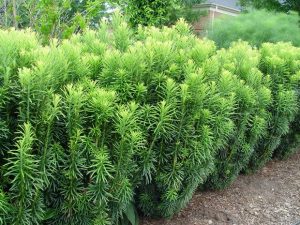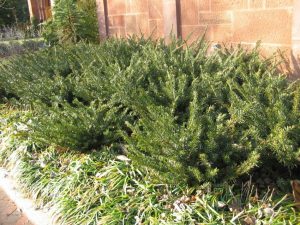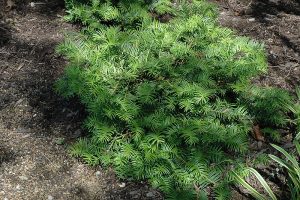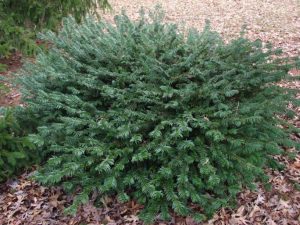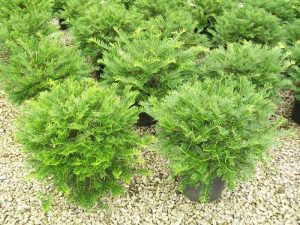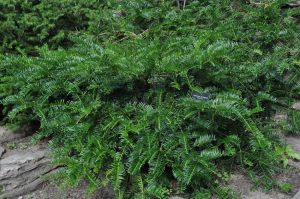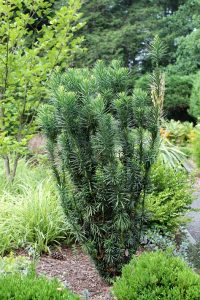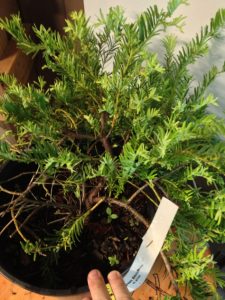Japanese Plum Yew
The Japanese plum yew is a deer-resistant small tree belonging to the plum-yew family. Its scientific name is in honor of the Earl of Harrington, who was the first plant this tree in a Europe.
This unique tree has long been valued not only for its ornamental qualities, but also for its medicinal properties. The plant has even shown potential in traditional medicine as an aid in treating certain diseases, including leukemia.
The plant’s medicinal applications come from compounds found in its bark, needles, and stems, which have been studied for their ability to inhibit the growth of cancer cells. One of the compounds of interest is cephalotaxine, which has shown cytotoxic effects, meaning it can potentially kill or inhibit the growth of cancer cells. Studies have suggested that cephalotaxine and related compounds may have promising applications in the treatment of leukemia and other types of cancer. However, it’s important to note that while these compounds have demonstrated potential in laboratory settings, further research and clinical studies are needed to fully understand their efficacy and safety.
- Omacetaxine mepesuccinate: is another alkaloid compound derived from the leaves, and is being developed as a drug for the treatment of hematological cancers, including leukemia.
- Anti-leukemia properties: Studies have shown that Omacetaxine mepesuccinate has benefits in patients with myelodysplastic syndromes and acute myeloid leukemia. Patients with solid tumors did not show any benefit so far.
In traditional Chinese medicine, plants in the Cephalotaxus genus have been used as a remedy to improve overall health and vitality, and their extracts have been explored as a supplementary treatment alongside more conventional therapies. Although the medicinal use of the Japanese Plum Yew is still under investigation, it remains an area of interest for botanists and pharmacologists alike.
Scientific Classification
| Kingdom | Plantae |
| Division | Pinophyta |
| Class | Pinopsida |
| Order | Pinales |
| Family | Cephalotaxaceae |
| Genus | Cephalotaxus |
| Scientific Name | Cephalotaxus harringtonii |
Quick Information
| Other Names | Korean plum yew, cowtail pine, Harrington’s cephalotaxus, Assam plum yew, plum fruit yew, spreading plum yew |
| Type | Evergreen shrub |
| Identification | Size: 5-10 ft (1.5-3 m) tall and 5-14 ft (1.5-4.3 m) wide Trunk Diameter: 4 ft (1.2 m) Needles (Leaves): Linear, 2 in (5 cm) long, 0.12 in (0.30 cm) wide, leathery, dark-green above and lighter green below, arranged on either side of the shoot Bark: Grey-colored Flowers: Males are pale cream-colored, becoming brown as they age, globular-shaped; females are spherical, can be found at the base of shoots Cones: Smooth, pale green with darker green stripes, ovoid-shaped, 1 inch long, 0.6 inch wide |
| Distribution | They are native to Japan and Korea |
| Habitat | Woodlands of deciduous forests at heights of 1,970-3,280 ft (600-1,000 m) |
| Hardiness Zones | 6-9 |
| Growth Rate | Slow |
| Lifespan | 50-150 years |
| Growing Conditions | Summer: Part shade during hot summers, full sun during cooler ones Winter: First year of winter should be in cover Water: Moderate Light Requirement: Full sun to full shade Soil: Sand, loam, clay |
| Diseases & Pests | None |
| Reproduction System | Dioecious |
| Propagation | By cuttings and seeds |
| Seedling Development | Germination may take more than a year and half |
| Cutivars |
|
| Uses | Ornamental; a substance known as omacetaxine, extracted from the leaves is used in treatment of leukemia |
| IUCN Conservation Status | Least Concern |
Interesting Facts
- Oil derived from the fruits of the Japanese plum yew is edible, as are the seeds.
- This plant is sometimes confused with the similar sounding Japanese yew.
References:
- http://www.missouribotanicalgarden.org/PlantFinder/PlantFinderDetails.aspx?kempercode=c769
- https://selectree.calpoly.edu/tree-detail/cephalotaxus-harringtonia
- https://landscapeplants.aub.edu.lb/Plants/GetPDF/91b93daa-46d8-4654-a25c-ab490dcf7b10
- http://rslandscapedesign.blogspot.com/2010/03/cephalotaxus-plum-yew.html
- https://www.thespruce.com/japanese-plum-yew-growing-profile-3269170
- https://pfaf.org/user/plant.aspx?LatinName=Cephalotaxus+harringtonia
- https://www.monrovia.com/spreading-japanese-plum-yew.html
Published on June 5th 2018 by Sudipto Chakrabarti under Yew.
Article was last reviewed on 5th December 2024.


